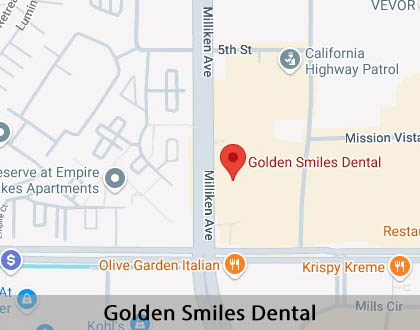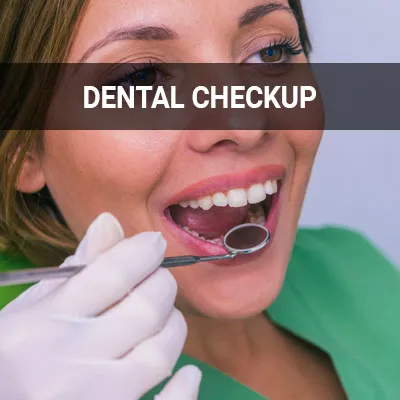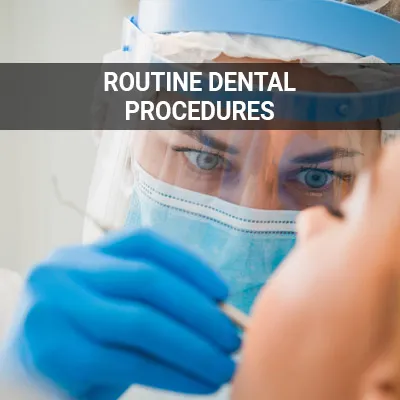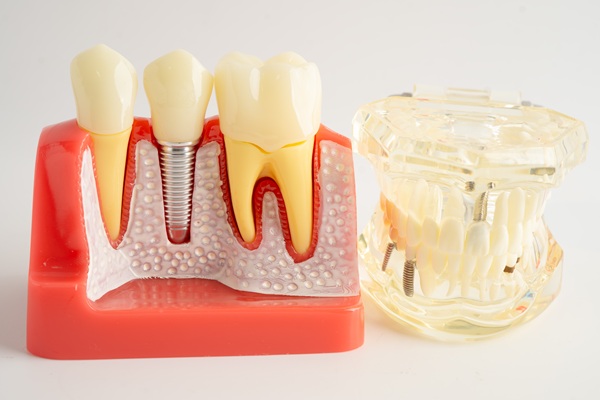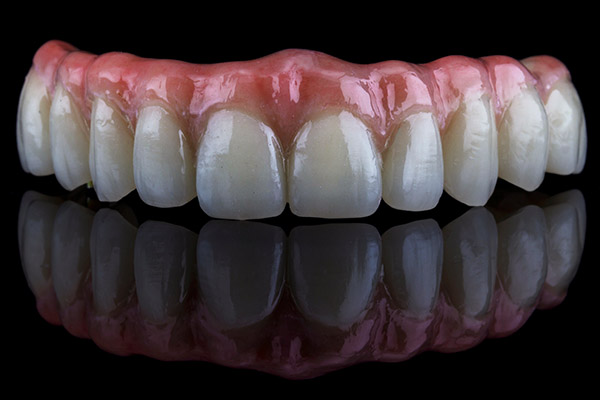General Dentistry Services Rancho Cucamonga, CA
A general dentist can perform most dental services. General dentistry includes preventative treatment and the diagnosis of many issues affecting the teeth and gums. Regular visits to a general dentist help prevent the development of serious dental problems.
General dentistry is available at Golden Smiles Dental in Rancho Cucamonga and the surrounding area. Our staff is ready to provide the necessary preventative care for your entire family. Call us at (909) 297-1966 to schedule an appointment.
What to Expect from the Dentist
A general dentist should be thought of as a primary care dental provider focusing on the diagnosis, treatment, and overall oral health care needs of the patient. This can include fillings, gum care, and even preventative education. Golden Smiles Dental will work with each patient to develop a customized dental hygiene plan.
A dentist also plays a role in a patient's overall health. Our staff will take a complete health history, including any medications they are taking, and discuss how they can affect oral health. For instance, diabetes is known to increase gum disease risk, while medicines contributing to dry mouth can increase tooth decay risk. Symptoms of other diseases can also show up in the mouth first.
Patients can also expect to discuss diet and oral hygiene habits. Other lifestyle habits, such as tobacco use, are necessary to disclose as well. It is essential to be upfront about any activities that can adversely affect oral health.
“A general dentist should be thought of as a primary care dental provider focusing on the diagnosis, treatment, and overall oral health care needs of the patient.”
Get Regular Checkups
Routine dental cleanings should be a part of everyone's life. While the most common recommendation is a visit every six months, The American Dental Association says the dentist should determine the number of visits needed for each individual. General dentistry visits help maintain good oral health by giving our staff a chance to stop the disease before it gets worse.
A typical routine checkup includes a thorough cleaning and polishing to remove any buildup of plaque and tartar on the surfaces of the teeth and along the gum line. New patient appointments and visits after a few years typically require X-rays as well. After the cleaning, Golden Smiles Dental will do a comprehensive exam, carefully checking all the teeth and any areas of concern. Afterward, we will discuss the results of the checkup and schedule a follow-up visit if needed.
“Routine dental cleanings should be a part of everyone’s life.”
General Services Available
A general dentist offers several services designed to address current problems and prevent any future issues. Patients do not need to suffer from bad breath or tooth pain. Our staff will discuss any oral health concerns and suggest corrective and preventative treatments.
When it comes to bad breath, the first step is to practice proper oral hygiene at home. If a buildup of bacteria on the teeth is to blame, we may recommend a mouth rinse that kills bacteria or toothpaste with antibacterial properties. If gum disease is suspected, the patient may require a deep cleaning.
Dental sealants and fluoride treatments both help prevent cavities. Sealants are a thin, protective coating adhered to the chewing surface of the back teeth, while fluoride is a liquid commonly used to strengthen the enamel of the teeth. While a combination of brushing and flossing is still the right way to fight cavities, both treatments are another layer of protection to help prevent tooth decay.
One of the most common dental services is removing tooth decay and placing a filling in the area. Fillings replace the part of a tooth damaged by injury or decay. This preserves the integrity of the tooth and prevents further damage.
“A general dentist offers several services designed to address current problems and prevent any future issues.”
Check out what others are saying about our dental services on Yelp: General Dentistry Services in Rancho Cucamonga, CA
Additional Treatments
General dentistry also offers additional treatments and screenings to treat more serious oral health issues such as broken teeth and gum disease. Patients should call the office as soon as they experience any dental pain or discomfort. The longer a patient waits, the more significant a problem can become.
A dental crown can protect weak and cracked teeth. A dental crown consists of a cap placed over the tooth to restore its shape, size, and strength. This procedure can also restore a tooth that is broken or worn down or support a tooth with a large filling.
Root canals are used to repair and save a tooth that is damaged or badly infected. Golden Smiles Dental will remove any decay and address the diseased portion of the tooth's pulp. The inside of the tooth is then cleaned, and the area is filled and sealed.
Gum disease, like gingivitis, can cause severe infection when left untreated. One option is deep cleaning. This involves scraping off the tartar both above and below the gum line, as well as root planning, which helps the gums reattach to the tooth. Golden Smiles Dental may also prescribe medications to help control bacteria.
We also offer oral cancer screenings. This is typically done during a routine visit and helps to identify concerns early. If needed, we may perform additional tests to identify areas of abnormal cells in the mouth.
“General dentistry also offers additional treatments and screenings to treat more serious oral health issues such as broken teeth and gum disease.”
Questions Answered on This Page
Q. What can I expect from the dentist?
Q. How often do I need to visit the dentist?
Q. What services are offered by a general dentist?
Q. What additional treatments are available at a general dentist?
Q. Why is dental education important?
People Also Ask
Q. What is involved in the dental cleaning portion of a checkup?
Q. How often should people see the dentist?
Q. How can someone find out what procedures their dental insurance covers?
Q. Why do I need my wisdom teeth or other teeth removed?
Q. What kind of pain can be addressed by a root canal treatment?
Learning from the Dentist
Education is a vital part of general dentistry. Patients who receive the necessary oral health education are more likely to keep appointments and are better equipped to recognize the signs of a more serious dental issue. By knowing what to look for, a patient can get into the office and start treatment sooner.
Golden Smiles Dental will provide information tailored to each individual's unique oral health and their specific concerns, including the necessary facts about prevention and maintaining oral health. An overview of basic dental health is also essential, such as the correct amount of pressure to use when brushing and how to floss and clean in-between the teeth properly. Such dental knowledge is vital for patients who want to keep their teeth healthy.
“Patients who receive the necessary oral health education are more likely to keep appointments and are better equipped to recognize the signs of a more serious dental issue.”
Frequently Asked Questions
Q. What is general dentistry?
A. General dentistry involves treating, diagnosing, and preventing diseases that affect the teeth, gums, mouth, and jaw. While it is necessary for good oral health, it can also impact your overall health.
Q. Why should I visit the dentist?
A. Regular dental checkups help you maintain good oral health and identify problems before they become serious. Golden Smiles Dental can also suggest preventative treatments that can protect you against tooth decay and gum disease.
Q. How often do I need to go to the dentist?
A. Typically, a patient will see the dentist twice a year. However, if you are at greater risk for gum disease or tooth decay, you may need to visit more frequently. Golden Smiles Dental will work with you to develop a treatment plan.
Q. What is gum disease?
A. Gum disease is caused by plaque and bacteria buildup that has been left untreated. Gingivitis is its most mild form. If not addressed, gum disease can lead to tooth and bone loss. Good oral hygiene at home and regular dental checkups can help prevent gum disease.
Q. How can I get rid of bad breath?
A. Bad breath is a symptom of poor oral hygiene. Regular, professional dental cleanings, good brushing techniques, frequent flossing, and tongue cleaning can help eliminate bad breath. Our dentist can also discuss additional options.
Q. How does fluoride work?
A. Fluoride helps to strengthen teeth and protect against decay. It is found in food and water and is also used in specially-formulated toothpaste and mouthwash. Golden Smiles Dental can also apply fluoride directly to the teeth using a gel or varnish.
Dental Terminology
Learn More About General Dentistry Services
General dentistry can not only help maintain oral health but also addresses many common concerns. Let Golden Smiles Dental in Rancho Cucamonga tell you more about improving your smile. Give us a call at 909-297-1966.
Helpful Related Links
- American Dental Association (ADA). Glossary of Dental Clinical Terms. 2024
- American Academy of Cosmetic Dentistry (AACD). Home Page. 2024
- WebMD. WebMD’s Oral Care Guide. 2024
About our business, and website security
- Golden Smiles Dental was established in 2013.
- We accept the following payment methods: American Express, Cash, Check, Discover, MasterCard, Visa, CareCredit, LendingClub, Proceed Finance, and Sunbit
- We serve patients from the following counties: Los Angeles County, San Bernardino County and Riverside County
- We serve patients from the following cities: Rancho Cucamonga, Alta Loma, Upland, Ontario, Fontana, Rialto, Chino, Colton, Eastvale and San Bernardino
- Norton Safe Web. View Details
- Trend Micro Site Safety Center. View Details
Back to top of General Dentistry Services

